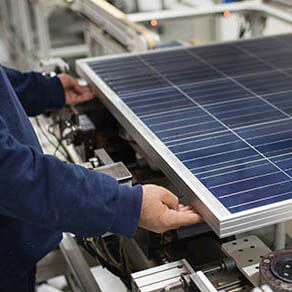
Is Your Manufacturing Company Eligible for Clean Energy Tax Credits?
The Inflation Reduction Act (IRA), enacted in late 2022, provides valuable tax credits that support clean energy manufacturing. Significantly, the law created the Advanced Manufacturing Production Tax Credit (45X MPTC), which is an incentive for producing clean energy components. In addition, the IRA expanded the Advanced Energy Project Investment Tax Credit (48C ITC) program. Eligible manufacturers that purchase property to re-equip, expand or establish facilities in relation to clean energy can apply for this credit, whose funding is limited.
Two caveats to keep in mind: Your manufacturing company can claim only one credit, not both. Also, both credits begin to phase out in 2032. Let’s take a closer look at each credit.
45X MPTC
The 45X MPTC is available to manufacturers that produce clean energy components in the United States. The credit varies by eligible component and is multiplied by the number of units produced and sold during the year.
What components qualify for the 45X MPTC? The list includes photovoltaic modules (commonly known as solar panels), as well as subcomponents, inverters, tracking system components, batteries and critical minerals. (Components produced at a facility that received a 48C ITC after August 2022 aren’t eligible.)
Of note, rather than using a 45X MPTC to offset taxes owed, manufacturers can “monetize” the credit through a direct payment from the IRS or by electing to transfer the credit. Using the direct payment option, manufacturers may receive a refund for the 45X MPTC for the first five years they claim the credit (subject to the 2033 credit sunset). The five-year rule doesn’t apply to manufacturers that are tax-exempt organizations (or to certain other comparable organizations). Excess payments may be subject to a 20% penalty.
Alternatively, manufacturers may elect to transfer all or a portion of the 45X MPTC for a particular year to an unrelated eligible taxpayer. Payments for the credit must be made in cash and aren’t treated as a taxable event. Again, a 20% penalty may apply to any excess payment.
48C ITC
The 48C ITC is a U.S. Department of Treasury program that was initially established by the American Recovery and Reinvestment Act of 2009. It awards tax credits for investing in eligible property. Generally, the property must be designed to produce or recycle advanced energy components, such as solar modules, inverters and batteries, but a wide variety of property may qualify. The credit represents a percentage of eligible investment costs placed in service during the tax year.
The IRA expanded the types of investments that can qualify for the 48C ITC program and provides $10 billion in funding for new credits to be allocated to projects beginning in 2023 or thereafter. At least $4 billion of the credits must be allocated to projects located in a tract that is designated as an “energy community” and hasn’t been allocated a 48C ITC prior to enactment of the IRA.
Beginning in 2023, manufacturers can apply to claim a 48C ITC of 30% of their qualified investment if they satisfy labor requirements issued by the Treasury Department relating to their manufacturing facilities. If a project doesn’t meet the labor requirements, it’s limited to a 6% tax credit. These labor requirements no longer apply after the facility has been placed into service.
Manufacturers must apply to receive the credit in compliance with other regulations or documentation required by the Treasury Department. The program will begin to accept applications on May 31, 2023, and competition for the limited funding available is expected to be stiff.
After a manufacturer is awarded an allocation, it has two years from the allocation date to provide evidence (for example, permits) that the requirements have been met in a timely fashion. The Treasury Department will then provide certification for the credit.
Unlike for the 45X MPTC, manufacturers can receive a refund for the 48C ITC only if they’re tax-exempt organizations (or certain other comparable organizations). As with the 45X MPTC, a 20% penalty may apply if excess payments occur.
Manufacturers can elect to transfer all or a portion of the credit for a given year to an unrelated eligible taxpayer. Payments for the credit must be made in cash and aren’t treated as a taxable event. Again, a 20% penalty may apply to any excess.
Choosing the Right Credit
So which, if any, of the two credits is right for your manufacturing company? If you won’t be manufacturing 45X MPTC-eligible components, the 48C ITC will be your only option. And know that you’ll benefit from the 48C ITC only if you apply in a timely manner, receive an allocation and meet the compliance requirements.
If your facility will be manufacturing 45X MPTC-eligible components, you likely will be better off going with the 45X MPTC. But there are no absolutes. Contact us for help in making an informed decision.
